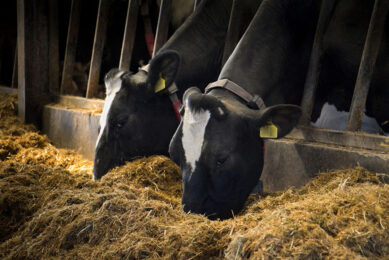Pioneering technology for protein nutrition in ruminants
Many trials have shown that the protein source in the diet of the dairy cow could have a marked influence on milk protein secretion. In practical ration formulation it is almost impossible to meet both the lysine and methionine constraints for high milk production (also meat production in beef animals and sheep) respectively from conventional raw materials alone.
The availability of good quality concentrated sources of bypass protein will permit the lysine and methionine constraints to be met and also give the formulator greater choice and flexibility in the other raw materials that can be incorporated to attain more dense overall dietary nutrient levels.
High-protein byproduct feeds
One approach for increasing the contribution of bypass protein to total CP in the diet is to feed high-protein byproduct feeds (e.g. maize gluten, meat, hydrolyzed feather, fish, and blood meals) that are already of lower ruminal degradability.
However, consumer resistance, cost, commercial availability, uniformity, amino acid balance and intestinal digestibility, bioavailability and palatability of products dictate their use. Amongst the vegetable proteins, soybean meal is above average in lysine and canola meal above average in methionine.
The problem with all vegetable protein sources (oilcakes) however is their rate and extent of ruminal degradation, therefore they do not contribute much to the overall bypass protein pool required to maintain high levels of production.
Artificially reducing degradation
An alternative approach to overcome the high rate of degradation of vegetable protein sources is to artificially reduce the rate of ruminal degradation of high protein oilseed meals that possess good amino acid balance and good intestinal availability. This approach:
- increases the choice of higher UDP feeds with which to optimise diets for UDP/RDP ratios, intestinal amino acid balance, and price,
- has the advantage of being applied to feeds of choice and of providing controlled ruminal protection so as to maximize protection with minimal reduction in intestinal digestion, and
- reduces the reliance on byproduct feeds as the only high UDP feed sources.
The right combination of rumen protected vegetable protein sources (e.g. soy for lysine with canola for methionine) therefore can offer the same benefits at dramatically reduced costs.
Unique rumen bypass technology
In conjunction with Kansas State University in the USA experts within AFGRI Operations in South Africa have been very successful in developing and commercializing a bypass protein technology (branded as AminoMax), which increases the rumen bypass protein ratio of more cost-effective and more beneficial vegetable protein sources by up to 250%.
In carefully controlled conditions, but without the addition of chemicals, proteins are bonded with sugars to produce rumen bypass proteins. These bonded proteins are resistant to microbiological breakdown in the rumen but on entering the intestine have a high digestibility allowing amino acids and peptides to be efficiently absorbed into the bloodstream available for the production of milk and tissue protein
The fact that very little amino acids are damaged in this unique process and most nutrients therefore remain available in the lower digestive tract for the animal’s production processes makes this technology unique worldwide.
Cost reduction of products
Extensive global research that has been conducted on this technology has shown this bypass technology to be superior to comparable processed proteins available. Where the technology has been introduced in the manufacture of dairy, beef cattle and sheep feeds, initial trials produced significant feed cost savings (cost per litre of milk or kg of meat) accompanied by increases in milk production and milk solids as well as carcass performance.
Fluctuating feed and product prices (milk, meat, etc) require that producers should always aim to maximize income over feed costs. Economically, it is important to improve efficiency of feed use, and thereby lower feeding costs. As the quantity of milk produced per cow continues to increase, it will be increasingly more difficult to meet specific nutrient requirements of the lactating dairy cow. It is our belief that many cows producing in excess of 30 kg of milk daily fail to produce to their genetic capacity because of the lack of some key nutrient.











